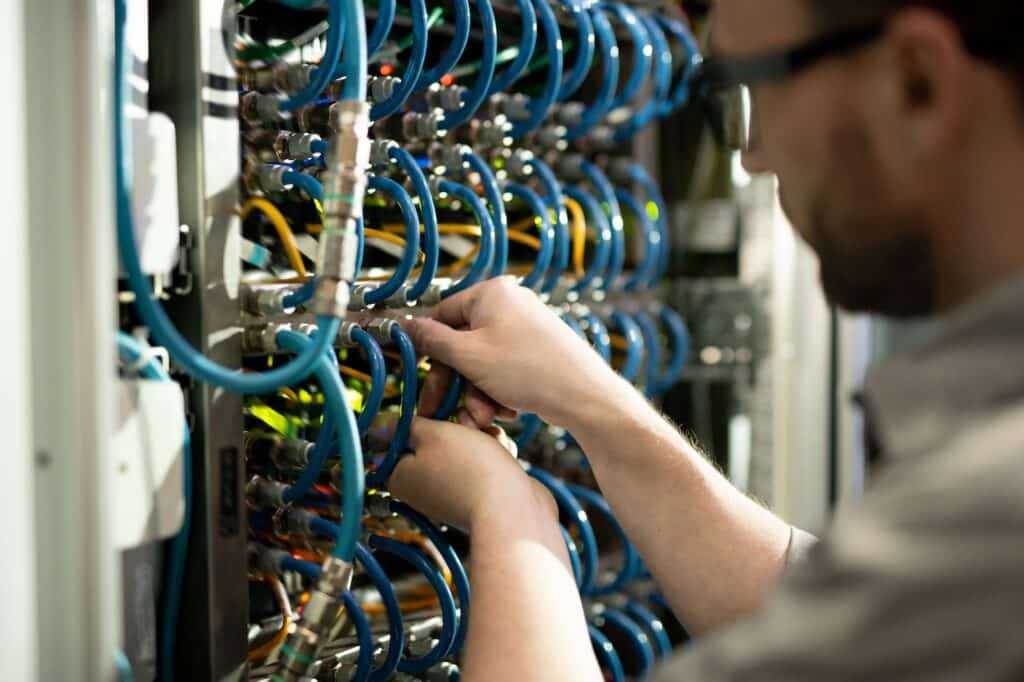|
Getting your Trinity Audio player ready...
|

Investing in a structured cabling system can be a game-changer for any business looking to enhance its network infrastructure. This guide will walk you through what you need to know about structured cabling and its benefits.
What is Structured Cabling and How Does It Work?
Structured cabling is a standardized cabling infrastructure that supports multiple hardware applications across an organization. Unlike traditional point-to-point cabling, where each device is connected directly to another, structured cabling uses a central hub to connect all devices.
This infrastructure forms the backbone of your network, ensuring seamless data transmission across various IT equipment. Additionally, this centralized approach allows for easier management and scalability as businesses grow and add more devices.
Benefits of Structured Cabling
A structured cabling system supports future technology upgrades and expansion, making it a wise investment for businesses of all sizes. Here are some major benefits you can expect from implementing structured cabling in your organization:
Improved Network Performance
Structured cabling eliminates the risk of network congestion and reduces downtime, resulting in improved network performance. This means faster data transmission and increased productivity for your business.
Scalability and Flexibility
Structured cabling systems are designed to be highly scalable, allowing you to easily add or remove devices as your business grows. This flexibility can lead to significant time and cost savings, as it minimizes the need for complex reconfigurations.
Ease of Maintenance
With a well-organized cabling system, troubleshooting and maintaining your network becomes much simpler. This reduced complexity can help you quickly identify and rectify issues, minimizing downtime and ensuring operations run smoothly.
Planning and Design Considerations
A successful structured cabling installation begins with meticulous planning and design. Here are some critical factors to consider:
- Building Layout: Understanding the physical layout of your building is essential. The design should account for all floors, rooms, and potential expansion areas to ensure comprehensive coverage.
- Site Survey: Conducting a thorough site survey can provide invaluable insights into potential challenges and opportunities. This assessment helps customize the cabling system to your specific needs.
- Network Requirements: Assess your current network requirements, such as bandwidth needs and the number of connections. This baseline will help you design a cabling system that meets your immediate needs while still allowing for future expansion.
- Future Growth Projections: Consider where your business is headed. Projecting future growth will help you design a scalable cabling system that can adapt to increasing demands.
Industry Standards and Regulations
Industry standards and regulations governing structured cabling installations are vital to ensuring a reliable and high-performing network. Key standards like TIA/EIA-568 dictate the requirements for cabling types, system architecture, and installation practices, enforcing consistency and interoperability across different vendors.
Compliance with these standards is crucial for ensuring that all components of the cabling system can work seamlessly together, enhancing network performance and reliability by reducing the likelihood of errors and downtimes.
Factors to Consider
When looking to integrate a structured cabling system, it’s essential to consider factors such as:
- Cable Type: Choosing the right type of cable with the help of experts is vital for meeting your performance and bandwidth requirements. Options include Cat5e, Cat6, and fiber optics, each offering different levels of speed and reliability.
- Bandwidth Requirements: Understand your bandwidth needs to select cables that can handle your data load effectively. This is particularly important for businesses that rely on heavy data transmission.
- Environmental Factors: Consider environmental conditions like temperature, humidity, and potential interference. These factors can affect the performance and longevity of your cabling system.
Get The Most From Your Structured Cabling System
Ongoing Maintenance
Maintaining your structured cabling is crucial for long-term performance. Regular inspections, cleaning, and updates can help keep your network in optimal condition.
Proper cable management is also essential for minimizing signal interference and ensuring optimal performance. Techniques like labeling, using cable trays, and organizing cables can make a significant difference.
Return on Investment (ROI)
Structured cabling means enhanced network performance, faster data transmission, and minimized risk of network failures. Investing in this system can yield significant returns through increased productivity, reduced downtime, and scalability, ultimately leading to substantial cost savings and improved efficiency over time.
Structured cabling systems are also designed to accommodate growth without significant reconfiguration. This scalability means businesses can seamlessly integrate new devices and technologies as they expand, avoiding the high costs associated with overhauling network infrastructure.
Enhance Your Infrastructure with Twintel
By investing in structured cabling, you’re not just enhancing your current network but also future-proofing your infrastructure for years to come. Make the smart choice and join the league of forward-thinking businesses today.
Ready to transform your network with a structured cabling system? Partner with Twintel to ensure a seamless and future-proof installation. Contact us today to get started and take your business to the next level.
TWINTEL Solutions has grown into an expansive, full team of IT services professionals, acting as the outsourced IT department of non-profits, small to mid-size businesses, and enterprise-level corporations.